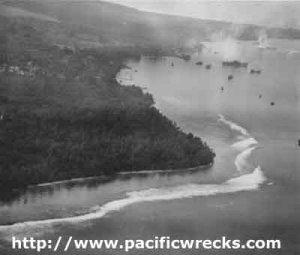![]() The Pacific War Online Encyclopedia
The Pacific War Online Encyclopedia
|
| Previous: Kauffman, James L. | Table of Contents | Next: Kawabe Masakazu |

U.S. Air Force.
Via PacificWrecks.com
Kavieng (150.793E
2.58S), located at the northwestern tip of New Ireland in the Bismarcks, had a
protected anchorage that
might have played an important role in the war if it had not been
overshadowed
by the great fortress at
nearby Rabaul.
The anchorage is handicapped by strong tidal
currents and
numerous shoals. Nonetheless, the Japanese
occasionally used it as an alternate anchorage to Rabaul. At the
outbreak of war, the facilities were barely adequate to load copra
from nearby coconut plantations. However, New Ireland had the only
all-weather road of any length in the Bismarcks, which ran
along the entire northeast coast of the island and had a spur to a
ferry landing on the southwest coast of the island across from Rabaul.
The anchorage was discovered by the Dutch
in 1516, but the first permanent white residents, German
missionaries, did not arrive until 1877. The Germans established
coconut
plantations that made the colony one of the more profitable in the
German
Pacific empire. The region was seized by the British
during the First World War and turned over to Australia.
Elements of 2 Maizuru SNLF (500 men)
occupied
Kavieng on 23 January 1942. The Australian garrison, which had just
completed an airstrip, cratered
its runway and retreated into the interior of New Ireland. The Japanese garrison
was later reinforced with 14 Base Force and elements of 5 Kure SNLF and 5 Sasebo SNLF.
The Japanese attempted to reinforce the garrison in December 1943, using battleship Yamato as a giant troop ship, but Skate scored a torpedo hit on Yamato on 25 December 1943 that did serious enough damage to force cancellation of the reinforcement attempt.
Kavieng was hit hard from the air the same day. Sherman's Task Group 50.2 raided the island with 86 aircraft and found the anchorage almost deserted. A weak counterattack that night by 4 G4M "Bettys" and 7 B5N "Kates" failed to score any damage. There were further raids in the next few weeks, including one on 1 January 1944 against a convoy returning from Rabaul to Truk that did little damage but drew off Japanese air strength during the Saidor landings.
Plans to carry out an amphibious landing against Kavieng were canceled on 12 March 1944. Kavieng was then bypassed by the Allied counteroffensive.
References
The Pacific War Online Encyclopedia © 2007-2010 by Kent G. Budge. Index